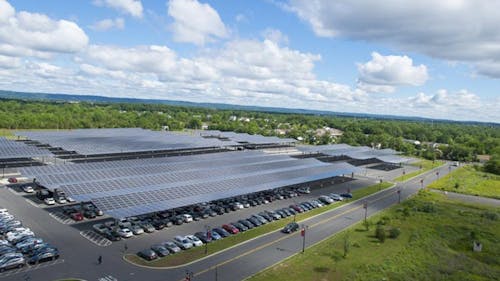Rutgers Climate Task Force releases interim report, creates Student Advisory Panel

Over the summer, the President’s Task Force on Carbon Neutrality and Climate Resilience published an interim report and began implementing other initiatives with the goal of increasing community input.
Angela Oberg, assistant teaching professor in the Department of Human Ecology and administrative director of the Task Force, said the Task Force is divided into working groups: energy and buildings, transportation, food systems, supply chain and waste management, land use and offsets, climate preparedness and climate-positive, equitable economic development. The latest report, she said, helps dictate how these groups will conduct their research.
“So (the report) was really twofold. One was to get a better sense of how the working groups were going to function, but that was also deeply influenced by the town hall, so what was important to the Rutgers community, what were they hoping to see, what were their impressions of what was happening,” she said.
Oberg said the interim report had three primary goals: establishing a baseline of the University’s current emissions and initiatives already being implemented to reduce those emissions, identifying problems and potential solutions and then evaluating those solutions. The working groups will all submit reports on their research, which will be combined into a single report and released in early October, she said.
To help establish a baseline of carbon emissions, she said, the Task Force sent out a survey to the Rutgers community in a University-wide email to ask questions about their behavioral patterns, preferences and activities.
“We can't necessarily know all of the carbon emissions that are related to Rutgers activities without knowing how people behave,” she said. “For example, we can get the information on how much carbon is emitted by the Rutgers buses, but we don't necessarily know how many miles people are commuting to and from class or to work, if you're faculty or staff.”
Oberg said it is important for members of the community to respond to the survey because it will provide better data for the researchers and help them identify potential solutions.
Another new development within the Task Force is the creation of a Student Advisory Panel (SAP). Oberg said the Task Force already had five student representatives who were nominated by the chancellors from New Brunswick, Newark, Camden and Rutgers Biomedical and Health Sciences (RBHS). To create the new panel, Oberg and the student representatives asked the deans, department chairs and student groups on the Newark, Camden and RBHS campuses for nominations, while at New Brunswick, they relied solely on the large variety of student organizations.
The student representatives conducted interviews over Zoom and voted on who to include on the panel, which now has approximately 20 representatives, Oberg said. The representatives are proportional to all four schools, with New Brunswick having the most representation.
Nolan Fehon, a School of Environmental and Biological Sciences junior and president of Students for Environmental Awareness, joined the SAP this summer and became a part of the visibility gap subcommittee, which he said also stemmed from the town halls.
Fehon said members of the Task Force noticed that many of the initiatives students called for at the town hall events were not necessarily the initiatives that would result in the most significant reduction in emissions, such as the proposal to electrify the bus system. Fehon said his subcommittee was made to keep other students informed on the Task Force’s findings.
“This ‘visibility gap’ is the term they use between what students are most passionate about reducing emissions for and what is actually going to reduce emissions most drastically,” he said. “The purpose is for us to be pushing out information from the reports and from all the research that the individual workgroups in the Task Force are pushing out so that students as stakeholders of Rutgers … have the most information they can have to make a good decision.”
Oberg said the second subcommittee works on event planning and is exploring ways to host more town halls this semester after the release of the integrated working group report despite the fact that most students are working from home.
“It's sort of a new landscape for us, how do we engage with the Rutgers community remotely,” she said. “I know a lot of us are becoming much more nimble with online platforms, but I know a lot of us are also a little fatigued by online platforms. So we're looking for ways to get the most feedback and to really be responsive to what's the easiest way for people to communicate to us.”
The third SAP subcommittee is focused on outreach, but due to the overlap with the visibility gap group, Oberg said these groups will now combine. She said the goal of the two groups is to continue the dialogue between the Task Force and the community outside of events such as town halls.
Fehon said at the town hall events last semester, many students expressed concern about staying informed on the Task Force’s progress.
“At the last town hall, I think the first recommendation that we got and the most prominent was that everyone was just harping on, ‘Please talk with us, please make sure that we have access to all this information,’ and so that's pretty much one of the main reasons the (SAP) was formed, is to make sure it's still going to happen,” he said.



